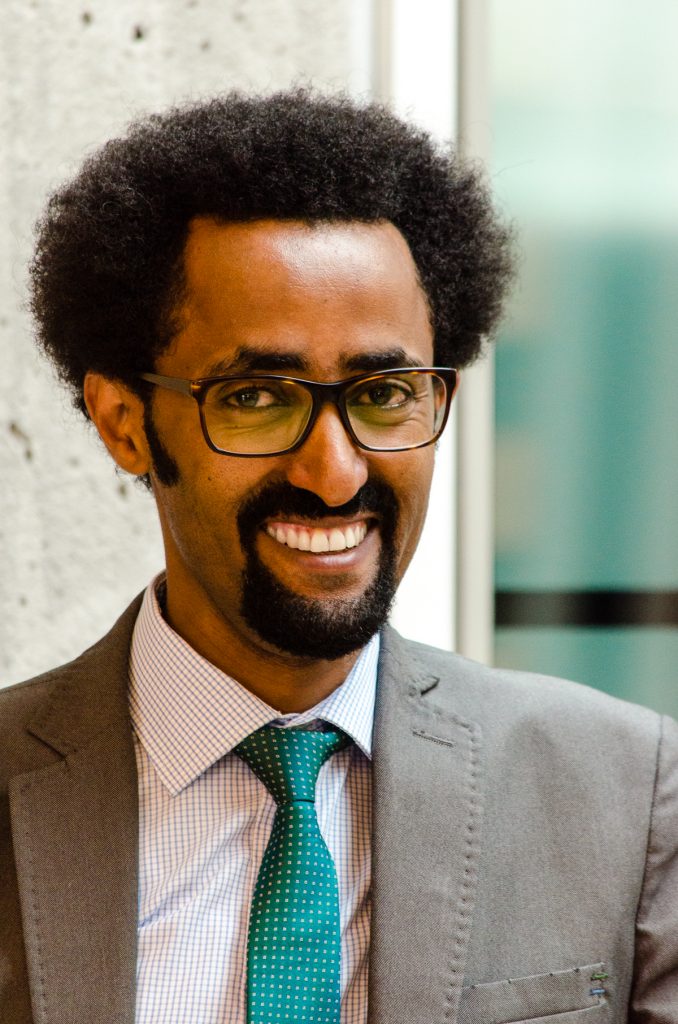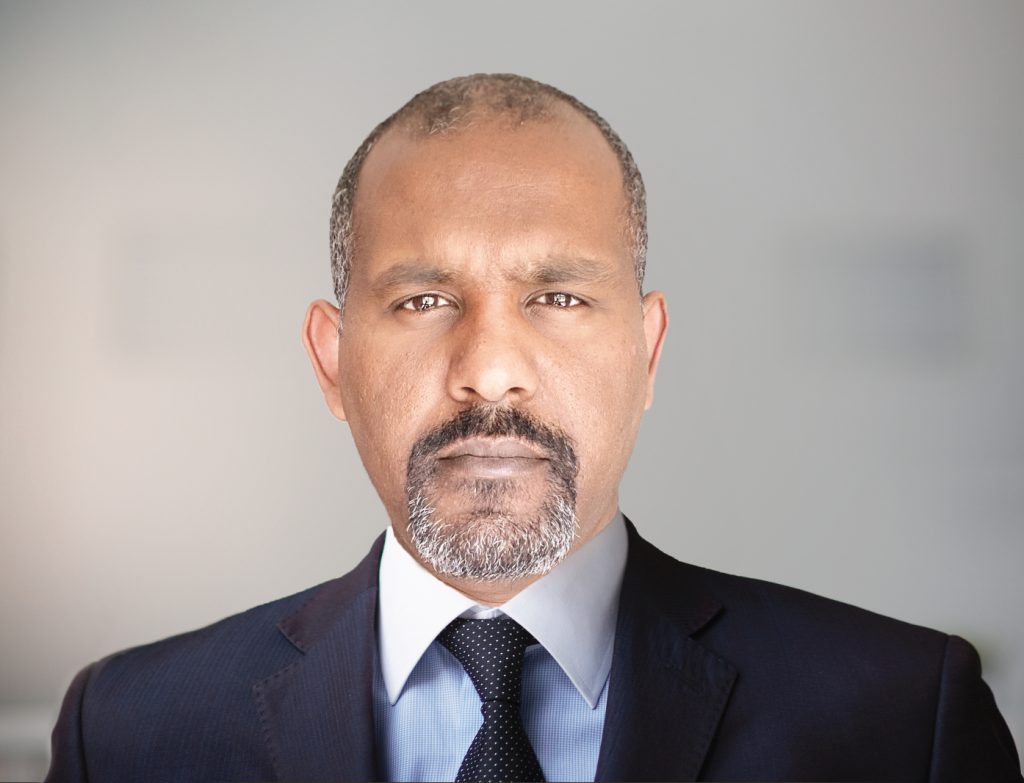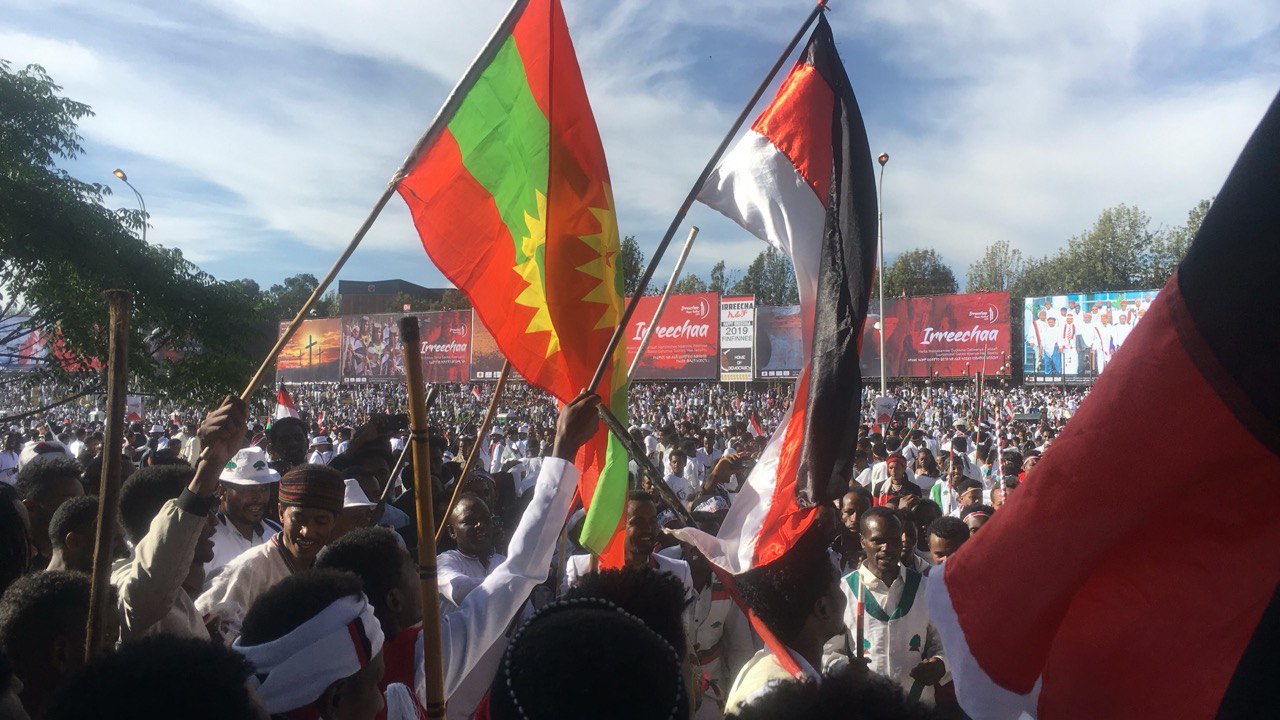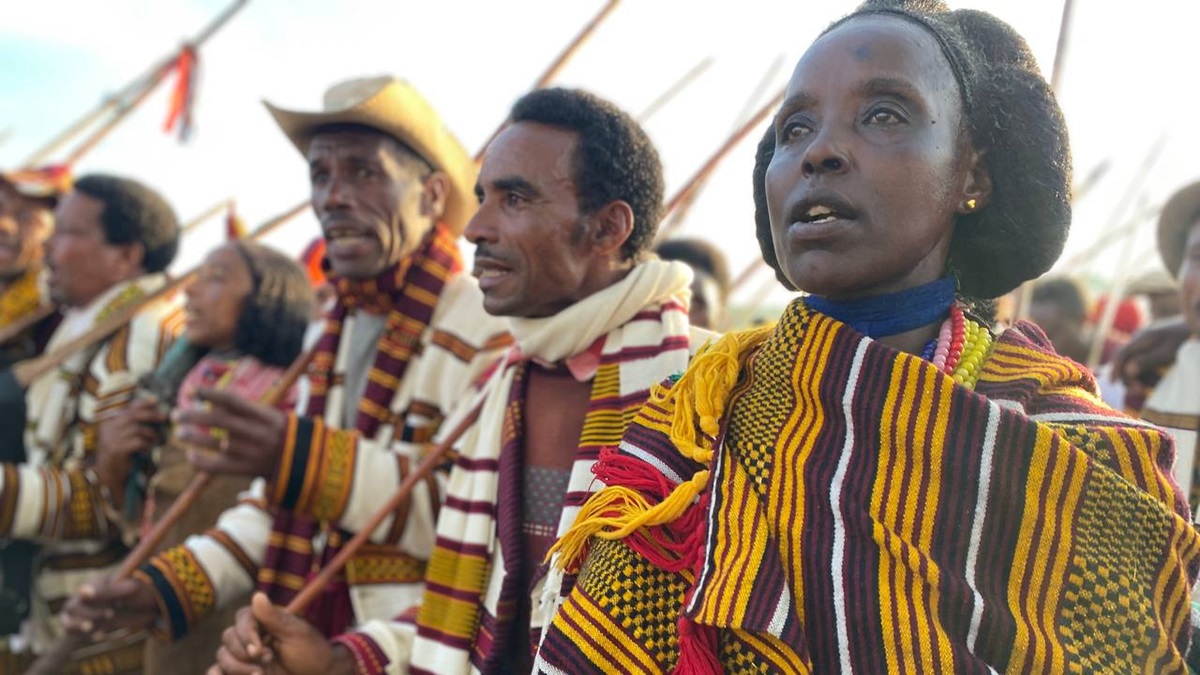Commentary: The pitfalls of Ethiopian elites’ war of narratives

Graphic design: Addis Standard
Shimelis Mulugeta Kene, PhD &
Solen Feyissa, PhD
Although seldom framed and understood as such, the current political conflict in Ethiopia has its roots in disagreement among the elite on how to narrativize Ethiopian history.
Addis Abeba, September 30/2020 – There is an enduring disunity among Ethiopian elites regarding its history and future. Informed by its long, and contentious multi-ethnic history, and fueled by recent shifts in the political landscape in the country, a war of narratives has been reignited. As we explain in this article, the narrative war is fought between adherents of what we have termed “Pan-Ethiopianists” and “Ethno-nationalists”. The spillover effect of this increasingly toxic debate has had a negative impact on the lives of everyday Ethiopians and continues to destabilize the country. Indeed, narratives surrounding ethnic identities and ethnic politics in Ethiopia is the one thing that demands the most attention. As it stands today, the way and environment in which the debate is occurring, and the actors involved in it indicates we may be approaching a threshold that cannot be uncrossed.
Nation-building narratives in the Ethiopian body politic
Nation-building is a contested process of narrative construction. In his book, Imagined Communities, Anderson reminds us that nations are “imagined political communities”. Common to all political communities is a set of beliefs in unifying narratives about community special characteristics. These narratives provide explanations to the participating individuals and their leaders what make their community unique, especially when compared to others. Nation-building in the Ethiopian context follows a similar pattern.
Faced with the burden of justifying maintenance of the Ethiopian state and their place at the top, Ethiopian rulers of the past relied on religious texts and edicts of the Ethiopian Orthodox Church. Written in the 14th century, the Kibre Negest, or “Glory of the Kings”, provided detailed accounts of the lineage of the Solomonic dynasty—the former ruling dynasty of the Ethiopian Empire—according to which Ethiopia’s rulers were descendants of King Solomon and the Queen of Sheba. It told the story of Ethiopia and Ethiopians as God’s people; a chosen people. It declared:
The people of Ethiopia were chosen [from] among idols and graven images, and the people of Israel were rejected. The daughters of Zion were rejected, and the daughters of Ethiopia were honoured; the old men of Israel became objects of contempt, and the old men of Ethiopia were honoured. For God accepted the peoples who had been cast away and rejected Israel, for Zion was taken away from them and she came into the country of Ethiopia. For wheresoever God is pleased for her to dwell, there is her habitation, and where He is not pleased that she should dwell she dwelleth not; He is her founder, and Maker, and Builder, the Good God in the temple of His holiness, the habitation of His glory, with His Son and the Holy Spirit, for ever and ever. Amen.
Similarly, the 12th century text Fitiha Negest, or “Laws of the Kings”, served as the country’s oldest traditional legal code. The Fitiha Negest insisted that kings must receive obedience and reverence. It justified the Kings’ power using scripture, specifically the words of Moses in Deuteronomy 17:15,
Thou shalt in any wise set him king over thee, whom the Lord thy God shall choose: one from among thy brethren shalt thou set king over thee: thou mayest not set a stranger over thee, which is not thy brother.
Ethiopia’s rulers used these texts to justify the state’s existence and their own power. But more importantly, as much as Americans take the Declaration of Independence as their founding moment, the Kebre Negest provided a similar “origins” story, albeit a contested one. For Ethiopians, while Fitiha Negest served as a constitution of sorts by laying out a minimal set of rules that bound the Kings and their subjects. As such, the Kebre Negest and the Fitiha Negest could arguably be taken as the most important founding texts of the Ethiopian state.
The 1700s witnessed an emergence of a new political structure where disparate noblemen usurped power away from Emperors of the Solomonic dynasty and began ruling over their own regions, a period known among Ethiopian historians as Zemene Mesafint, or Age of the Princes, named after the Book of Judges. In 1855, Emperor Tewodros II, born Kassa Hailu, rose to the throne after defeating regional noblemen. He recognized the need for a newer narrative that was closely aligned to his vision of Ethiopia as a modern, forward thinking nation. In line with that vision, his first step was to separate Church and State, shift its narrative and establish the state on a more secular foundation. To do so, he needed better educated Ethiopians, and thus began an elite-led nation building process. His efforts however did not bear fruit due to fierce internal opposition driven largely by disgruntled clergy, who, fearful of losing their own privilege and power, were unappreciative of his radical ideas.
Subsequent rulers of Ethiopia mended the “glitch” and followed the path that almost was dismantled by Emperor Tewodros II, and, as a result, the Ethiopian Orthodox Church remained inseparable from the Ethiopian state, and, with that, the state narrative. That, however, changed with Emperor Menelik II assuming the throne in 1889. Although the historical Ethiopia dates back to millennia, Emperor Menelik is widely considered as an architect of the modern Ethiopian state. His epic defeat of the Italian colonial power at the Battle of Adwa added another, if not stronger, element to the myth of God’s-chosen-people identity to Ethiopians and the Ethiopian state. As the Ethiopian historian Bahru Zewde recounts in his book Pioneers of Change, eager to modernize Ethiopia, Menelik sent Ethiopians to Europe and the U.S. for higher education. Unlike the church-educated elites that preceded them, these early Western-educated Ethiopian elites broke with tradition and became critics of the state. It may be argued as such that Emperor Menelik could be credited with spearheading the creation of a new intellectual-elite class and with bringing the same to the center of state politics. Unbeknown to him, with that he laid the groundwork for the creation of a new elite class that would later challenge the very essence of Ethiopia as a nation state.
Walleligne and the birth of Ethno-Nationalism
When Emperor Haile Selassie rose to the throne in 1930, he was acutely aware of the shortage of educated Ethiopians to build Ethiopia’s nascent civil service and bureaucracy. In order to fill in this gap, like his predecessor, he sent many Ethiopians to Europe and the U.S. for higher education that in the words of Jon Abbink produced “a generation of daring, innovative intellectual leaders and thinkers”. However, sadly many of these intellectuals were annihilated by the Italian colonial power in the late 1930s. This loss of its brightest left post-war Ethiopia with deep psychological scar and decades of stagnant time devoid of social and political change. With the founding of the University College of Addis Abeba in 1950, the future Haile Selassie University (now, Addis Abeba University), Emperor Haile Selassie’s dream of producing educated Ethiopians amass finally came true.
The 196o’s is when the role of Ethiopian intellectuals in the country’s politics probably got its most consequential phase. Starting in the 1960’s, with the backdrop of broader social unrest, university students started to oppose Haile Selassie’s single-man authoritarian rule and the oppressive socio-economic and cultural structures within which the students said the Imperial government and its predecessors functioned. They demanded rights and freedom. It was until a more radical wing of the movement sprang that, concurrent with the more mundane demand for reform, started to question the very essence of the Ethiopian state as a nation. Compared to the reformist intellectuals of the previous generation, Ethiopia’s newly minted intellectuals displayed impatience and lacked foresight in their calls for radical social and political reform. Jon Abbink might not be far from the truth when he observed these intellectuals’ “wholesale adoption of unmediated Western ideologies and abandonment of Ethiopian values” had had “quite disastrous consequences.”
An influential short essay written by Walleligne Mekonnen—who at the time was a second-year political science student at the university, and who was later on shot and killed along with fellow activists while attempting to hijack an Ethiopian Airlines flight–titled, “On the Question of Nationalities in Ethiopia” became a founding text of the radical wing of the student movement. In his essay, Walleligne argued that “Ethiopia is not really a nation” but rather “made up of a dozen nationalities with their own languages, ways of dressing, history, social organization and territorial entity.” However, this reality, according to him, was suppressed by the ruling class. Instead, a “fake Ethiopian nationalism” that is based on the linguistic and cultural superiority of the Amhara and, to a certain extent, the Amhara-Tigre, was imposed on the other peoples of Ethiopia, resulting in asymmetrical relations among the “nations” of Ethiopia. Therefore, according to Walleligne, the Ethiopian state came to be through the linguistic and cultural assimilation of the peoples of the wider South by the North—the Amhara and their junior-partner-in-assimilation, the Tigre. And, that this project of constructing Ethiopia was aided by the trinity of (the Amharic) language, (Amhara-Tigre) culture and religion (the Ethiopian Orthodox Church). He was, of course, echoing arguments Stalin, Rosa Luxemberg and others made about nations, nationalism and self-determination. Stalin, for example, lays out his thesis in Marxism and the National Question, as does Rosa in The Right of Nations to Self-Determination.
Walleligne, thus called for the dismantling and replacement of this “fake [Ethiopian] nationalism” with a “genuine Nationalist Socialist State” that he argued could only be achieved “through violence [and,] through revolutionary armed struggle”. To be sure, Walleligne did not see “secession” as an end in and of itself; nonetheless, he propagated it as a means to building the future egalitarian Ethiopian state, with the caveat that such secession should be rooted in and guided by “progressivism” and “Socialist internationalism”. He closed his essay with what may be considered prophetic: “A regime [Haile Selassie’s government] like ours harassed from corners is bound to collapse in a relatively short period of time. But when the degree of consciousness of the various nationalities is at different levels, it is not only the right, but the duty, of the most conscious nationality to first liberate itself and then assist in the struggle for total liberation.” Haile Selassie’s government did collapse in 1974.
That movement, spearheaded by the intelligentsia as it were, was hijacked by the Dergue – a collective of disgruntled low-ranking military officers in the imperial army – that not only succeeded in overthrowing Haile Selassie’s government, but also in ruling Ethiopia with an iron-fist for the next 17 years. But, the political and armed struggle for “liberation” continued. It was in this atmosphere of radicalization of the intellectual-elite class that discourses like “liberation” and the “oppressor-oppressed” took hold in the Ethiopian body politic and a plethora of liberation fronts mushroomed: the Eritrean Peoples’ Liberation Front (EPLF, 1962)—that succeeded in seceding Eritrea from Ethiopia in 1991—the Oromo Liberation Front (OLF, 1966), and the Tigray People’s Liberation Front (TPLF, 1975) to name but the most important ones. Dergue’s 17 years in power was marred by the bloodiest times in Ethiopian modern history, the Red Terror, and a border war with Somalia (1977—1978) and, more importantly, the protracted civil wars with TPLF, EPLF and OLF.
After 17 years of armed struggle, the Ethiopian Peoples’ Revolutionary Front (EPRDF) defeated the Dergue and controlled Ethiopian state power in 1991. EPRDF was a coalition composed of the TPLF, The Amhara National Democratic Movement (ANDM), the Oromo Peoples Democratic Organization (OPDO) and the Southern Ethiopia Peoples Democratic Front (SEPDF). It should, however, be noted that it was only with victory in sight against the Dergue and a desire to expand its sphere of influence beyond Tigray, that the TPLF formed the EPRDF in 1988. Otherwise, the actual power holder within the coalition remained TPLF. Consequently, the EPRDF introduced the 1995 constitution. Adopted in the immediate context of the post-Cold War, in a way that reflects the politics of constitutionalism and especially the shrewdness and pragmatism of the man behind it, the late Meles Zenawi, the constitution was a compromise between TPLF’s deep-rooted Marxist-Leninist ideological moorings and the post-Cold War euphoric triumphalism of liberal constitutionalism and human rights. So much so that the constitution declares the inviolability and alienability of human rights and freedoms emanating from the nature of mankind. However, as his building a de facto one-party state would later reveal, this was a move that seems to have been motivated more by placating the West than a genuine desire on the part of Meles’s EPRDF to champion the causes of human rights and democratic values.
The constitution divided Ethiopia into nine ethno-linguistic states that -with the exception of what is called the Southern Nations and Nationalities Regional State-are based on the ethnic identities of residents of those states. Most importantly, the constitution grants the “Nations, Nationalities and Peoples” within those states the unconditional “right to self-determination, including secession”. In other words, rather than with a people, sovereignty resides in a plurality of peoples of Ethiopia. It is these peoples that came together to form Ethiopia and they are the custodians of Ethiopia, from which they have the absolute right to secede if they so wish. That way, the constitution replaced the age-old notion of Ethiopia as a nation with an Ethiopia as a “nation of nations”. “What are the Ethiopian people composed of? I stress the word peoples because sociologically speaking at this stage Ethiopia is not really a nation”, so said Walleligne almost quarter of a century before and it came to be through the 1995 constitution.
From then on ethnicity became a determinant factor and dominant political currency in the Ethiopian politics, bringing with it, in the words of the late Donald Levine of University of Chicago, an “epidemic of ethnic and regional hostilities”. In addition to changing the way the country organized itself politically, EPRDF also sought to reframe the very foundation of what it means to be an Ethiopian and how Ethiopia itself came to be. Not unexpectedly, EPRDF targeted schools and educational institutions in particular as spaces where new narratives of Ethiopian history could be inculcated, so much so that Ethiopian universities became flashpoints of ethnic conflicts among students. Walleligne’s abstract, and as he himself admitted in his writing, incomplete, idea found a home in the curriculum. With this entrenchment of a “new” history of Ethiopia and a generation educated in the new curriculum and the alienation of “pan-Ethiopianism” from the Ethiopian body politic, it seemed that the “old Ethiopia” had died and been buried. But, as the 2005 Ethiopian election showed, a pan-Ethiopian party called the Coalition for Unity and Democracy (CUD) almost clinched power in major cities and rural areas if it had not been suppressed and finally expelled from Ethiopian political landscape. In fact, it was that election that gave the close to two decades-long ethnic politics championed by EPRDF, a real challenge and, more importantly, sowed the earliest seeds of the revival of pan-Ethiopian politics.
The unlikely emergence of Abiy Ahmed as Ethiopia’s premier: The re-emergence of Pan-Ethiopianism?
Meles Zenawi – the ex-guerrilla fighter who, as a Prime Minister, was reported to have made authoritarianism respectable – died in a Belgian hospital in 2012. Although political pundits thought in Meles’s absence Ethiopia would plunge into crisis immediately, his successors managed to stave off social unrest until protest rallies started to emerge in the Oromia region following the unveiling of the Addis Abeba Master Plan in April 2014. Months of sustained protests resulted in hundreds of deaths and even more people being imprisoned. However, the draconian measures did little to slow the protests. The EPRDF government eventually backed off from its aggressive actions against protestors and shelved its ambitious master plan, but it was too late. The protest had picked up steam and expanded to several other regions, including the Amhara region. Protestors demanded rights, representation, and economic justice. Tellingly, these protests erupted a few months after EPRDF claimed to have won 100% of the 2015 elections and only months after President Obama praised the government as being “democratically elected.”
The TPLF-led EPRDF government could not sustain its political power. In the backdrop of a fierce intra-party scuffle, in April 2018, Abiy Ahmed, son of an Amhara mother and an Oromo-Muslim father, and a member of the OPDO, ascended to power. With his promise of leading Ethiopia through transition to democracy, Abiy immediately began introducing a plethora of reforms, including inviting home all opposition parties and appointing some prominent public figures to key positions within his government. These and many other earlier reforms won him almost universal support from Ethiopians and the international community. In 2019 he won the Nobel Peace Prize for brokering a peace-deal with neighboring Eritrea, ending a two-decade long stalemate, following the 1998 border war between the two countries that claimed more than a hundred thousand lives.
Despite the indisputably positive changes, he introduced and results achieved, Abiy’s Ethiopia also saw its most turbulent years in recent Ethiopian history, including internal displacements, violence that claimed the lives of hundreds—including the murder of the brother of one of the authors of this article, an attempted assassination on the premier himself, high-profiled assassinations, and skirmishes with a splinter military wing of the OLF, Oromo Liberation Army (OLA) in western and southern Oromia region. There also is the ongoing tension with TPLF—whose top leaders are now in their stronghold Tigray region—that has the potential to erupt into a full-blown war with the federal government or the bordering Amhara regional state. Abiy’s recent decision to postpone the August national election due to COVID-19 has further destabilized the country and put in tatters his promise of transitioning Ethiopian into democracy. Further complicating Abiy’s agenda of stabilizing the East African nation is the tension with Egypt in relation to the Grand Ethiopian Renaissance Dam (the GERD) and broader geopolitical issues.
It was amid this ongoing turmoil Abiy established the Prosperity Party at the end of 2019, which brought together three of the four major parties that constituted the EPRDF as a coalition and five other smaller parties, considered within party circles as “allies” to the EPRDF. Based on his vision of national unity among Ethiopians that he calls medemer, which literally means “coming together”, this re-branding of EPRDF was meant to stave off the ethnically divisive politics and address ethnically motivated conflicts that engulfed the country during EPRDF’s 27 years in power. This seemingly mundane action, however, did not sit well with everyone and it brought to the surface a dormant issue for the last quarter of century in the Ethiopian formal political scene, namely: how to historicize Ethiopia. There is now an all-out war of narratives among Ethiopian elites on the history of Ethiopia.
The war of narratives
This narrative war is fought between adherents of what we have termed “Pan-Ethiopianism” and “Ethno-nationalism”. The ethno-nationalist camp takes Walleligne’s thesis as accurate representation of Ethiopia as a nation of nations. As we have noted, in mainstream Ethiopian history, Emperor Menelik is considered as the architect of the modern Ethiopian state. He is especially credited with expanding the Ethiopian empire to the South from his Northern strong-hold of Shoa. To the outside world and to Ethiopians alike, his epic victory over the Italian colonial force in the Battle of Adwa is widely celebrated as a key moment in Black anticolonial consciousness. In stark contrast to this picture, in the ethno-nationalist discourse, Emperor Menelik figures as the archenemy. To the ethno-nationalists Menelik’s supposedly mundane “state-building” endeavours were marked by violence, forced assimilation and suppression of cultures of peoples of the South, especially the Oromo. Echoing Walleligne’s thesis, they insist that rather than a nation built on the consent of the “nations, nationalities and peoples” of Ethiopia, Ethiopia is imposed on the wider South through conquest, violence and assimilation by Ethiopian rulers of Amhara, and to a certain extent, Tigre extraction. In their view, rather than an inclusive multicultural state, Ethiopia is made in the image of the Amhara and the Tigre.
Quite to the contrary, those in the Pan-Ethiopianist camp embrace the historical Ethiopia and adhere to the idea of Ethiopia as a nation-state. While not ruling out the presence of violence, they reject the “empire thesis” of the ethno-nationalists and hold that Emperor Menelik was just engaging in state-building when he conquered and brought the wider South under his Imperial rulership. In the Pan-Ethiopianist narrative of Ethiopia, the assimilationist and imperialist expansion of Emperor Menelik and his predecessors to the South is a normal historical process inherent to state building. There are also some within the Pan-Ethiopianist camp that insist that Emperor Menelik did not actually conquer and control “new” territories, but only “re-claimed” territories that hitherto were parts of the historical Ethiopia. There are still those in this camp that argue that it is in the nature of an empire to conquer peoples and rule over lands, and hence there is nothing anomalous about Emperor Menelik’s deeds.
Not surprisingly, many in the Pan-Ethiopianist camp saw, at least in the beginning, Abiy’s formation of the Prosperity Party as a move in the right direction with a potential to dismantle the current “ethnic-federalism” – that adherents of this camp hold is the root cause of the cycles of conflicts and other problems that the country faces – and eventually realize a unified Ethiopia, albeit federalist. Quite to the contrary, the move did not sit well with the ethno-nationalist camp, the TPLF in particular, openly opposing this merger as “illegal” on the ground that all constituent parties of the EPRDF should have consented to the dissolution of EPRDF and the merger. The Oromo activists in particular see in this merger and Abiy’s other reform agenda a return to the old Ethiopia, in which they argue Oromos were culturally and linguistically alienated by the Amhara-Tigre elites that in the past had a monopoly on state power. The recent murder of Hachalu Hundesa, a prominent Oromo singer, and the steps the Ethiopian government has taken in the aftermath of his death, they posit, solidifies their claim that Ethiopia has no room for the Oromo people.
Social Media and narratives of hate
The elites’ reach and impact has expanded as the means of information sharing and consumption has expanded. It is no more the traditional intellectual-elite class that engages in the production and dissemination of information that advances knowledge. Unlike the closely-knit intellectual class of earlier times, the debate now has a diverse body of actors: activists, political party operatives, and, as oxymoronic as it sounds, intellectual-activists. The elites with the loudest voices use low-trust and high-reach communication mediums like Facebook, Twitter and other social media to peddle their own facts and pursue their own agenda. Social media as it exists today rewards absolute claims, purity, good and evil binaries, and unequivocal declarations of truth that leave little room for compassion, reasoning, careful interpretation, and nuance. Fueled by algorithms that favor combustible content, social media companies orchestrate human interaction that lead individuals to maintain extreme positions and be adversarial towards one another.
The emerging Ethiopian elites in both camps have harnessed social media in ways that have yielded extraordinary influence and power over political discourse that directly and indirectly affects the lives of everyday Ethiopians. They recognize their charisma is more significant to their audience than the contents of their speech or the quality of their argument. Name calling, and ad hominem attacks, are their currency and they invoke current and historical grievances, and narratives of superiority to stoke fear and anger. Unfortunately, the narratives these elites broadcast are not without consequences. There is a correlation between recent violence in Ethiopia and the supposed adherents of these narratives.
Nothing makes the dangers of the deep division between the two camps as the recent murder of the renowned Oromo singer, Hachalu Hundesa. This incident has clearly shown their tendency to see and interpret any and every incident or issue in ways that support their respective narratives. Unfortunately, as is quite common in the post-truth social media age we live in, it is as though elites in each camp use—no matter what facts on the ground dictate—different truth-filters. So much so that, immediately after the news of Hachalu’s death surfaced, with no evidence at their disposal, elites in each camp took to social media and started to speculate who might have shot and killed the singer, and expectedly, started to point fingers at each other. In the ethno-nationalist camp, a conspiracy started to circulate that claimed the killing was orchestrated and carried out by “neftegna” and statements like “They killed our hero” reverberated around social media followed by wide-spread Oromo protests in Ethiopia, Europe and North America. On the other hand, in what appears to be due to Hachalu’s pro-Oromo nationalistic political views, in the Pan-Ethiopianist camp there was either a deafening silence, and, some even suggesting that the killing was a result of intra power-struggle among the Oromo elite politicians who just “sacrificed” Hachalu for their own politically calculated ends. Amidst the confusion and unsubstantiated claims floating around, even some media outlets broadcasting hate-filled messages, violence erupted in the Oromia region, which claimed the lives of over 200 individuals, the displacement of thousands and property damage.
If anyone in either camp is insensitive enough to bring havoc to Ethiopia, or even worse, to sacrifice precious human lives in pursuit of political ends or to prove a particular narrative of Ethiopia, then the debate is not so much about liberation and freedom as it is about ideology or some other ends. As Edward Said chastises us,
the standards of truth about human misery and oppression [are] to be held despite the individual intellectual’s party affiliation, national background, and primeval loyalties. Nothing disfigures the intellectual’s public performances as much as trimming, careful silence, patriotic bluster, and retrospective and self-dramatizing apostasy.
We shouldn’t also lose sight of the fact that, while not denying that there are genuinely invested individuals and groups of actors in each camp, there are still many in this “war” owing to other factors that have little or nothing to do with a genuine concern for Ethiopia and everyday Ethiopians. The harsh truth is that this is not just a debate about history, identity, or self-governance. It is also, if not more so, about elites’ drive for resource monopolization and the prestige that comes with power and other factors external to the debate.
Abiy’s government, like the EPRDF before it, is attempting to limit internet access, especially to social media, to quell recent unrest. The government’s desperate act to avoid future incidents like these are understandable. Expanded internet access to all, in theory, at least, is a positive development in the right hands. And it would be misguided to argue that the broadening of access to free speech that has been made possible through social media is wrong or detrimental. The detriment, actually, is with the unchecked nature of social media. As well, the absence of meaningful fact checking and understanding of local knowledge among social media companies make it possible for misinformation to spread easily.
Whither Ethiopia? The way forward
As we noted initially, nation-building is a contested process and the path to consensus is neither linear nor guaranteed. Consensus is especially difficult to achieve in a nation as ethnically, culturally and linguistically diverse as Ethiopia. This has become a singularly arduous task especially now that a generation of Ethiopians have grown up in an EPRDF Ethiopia, who are more and more alienated from actual inter-ethnic-lived experiences of Ethiopians of present and past generations. It is also naive to expect the debate to remain even-tempered. Emotions can run high as communities attempt to reconcile their identity and group status as they negotiate the meaning of their shared history with others. However, prerequisites to making meaningful progress are high-trust communication mediums, shared facts and shared goals. At the moment, the opposite appears to be true.
Each side accuses the other side of positing totalizing narratives, but there is a glaring absence of willingness on both sides to engage in reasoned debates with each other leaving no room to explore the authenticity and truthfulness of alternative narratives. What is worse, social media being the dominant medium of communication—which thrives on disagreements and antagonism—it is even questionable if such engagement is possible, or even the intended goal. It is not an accident that much of the narrative war is being fought on social media. Social media is fertile ground for having one sided debate. For the elites, it is a place where captured attention can be exchanged for dollars and because of it, careful analysis and nuance—arguably the most important characteristics of intellectuals— are disincentivized.
To use Edward Said’s words, “aggrieved primal innocence”- owing to past or present perceived or actual violence – or a sense of self-righteousness are the least of positions to start a debate on a history as long and contentious as Ethiopia’s and a process of nation building, which has been made even more complicated with the divisive ethnic politics of the last 28 years. Nonetheless, even if we disagree on where we started and how we got here, we could at least agree on where we are heading. To be sure, it may still be argued that we would not know where we are heading if we do not know where we started. That may very well be the dilemma we might have to learn to live with and, even the right place to start the debate. But denialism, lack of empathy, and cancel-culture are the last traits we should carry into this debate not only because people’s lives, but also the future of Ethiopia as a state, are at stake. Good faith debate based on shared facts and shared goals are required if the historical Ethiopia is to survive another century. AS
___________________________________//__________________________________

Editor’s Note: Shimelis Mulugeta Kene, Ph.D., is a human rights and legal scholar. Dr. Kene received his Doctorate in Civil Law (DCL) from McGill University where he studied as an O’Brien Fellow at the Centre for Human Rights and Legal Pluralism and LL.M (Hons) in International Human Rights from Northwestern University. He can be reached at shimelis.kene@mail.mcgill.ca

Solen Feyissa, Ph.D., is an academic technologist at University of Minnesota. Dr. Feyissa’s work in ICT for education strive for balance between humans, technology, and the environment. Solen is a frequent collaborator on international projects in a wide range of fields and disciplines including education, communication technologies, and development. An avid photographer, his photos have appeared in national and international publications including Vice, Yahoo! News, and MIT Technology Review. You can connect with him on Twitter: @solenfeyissa.








